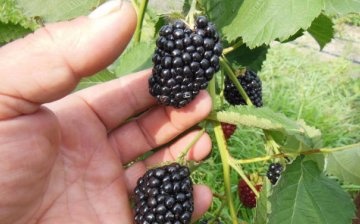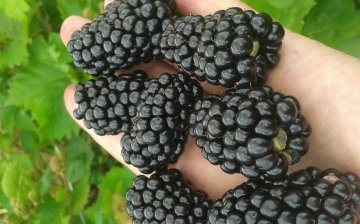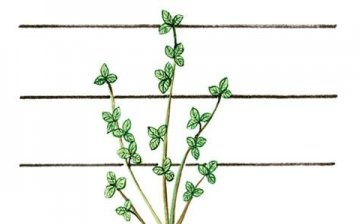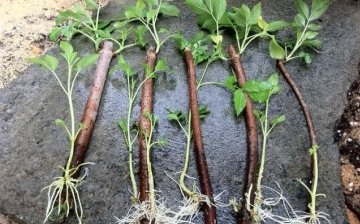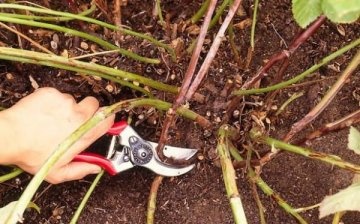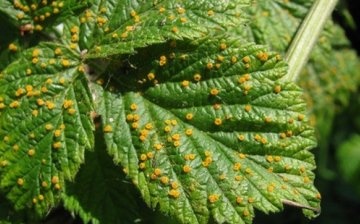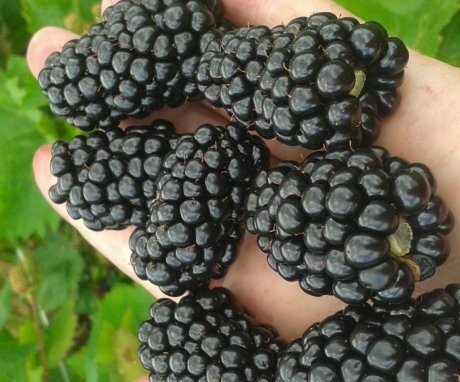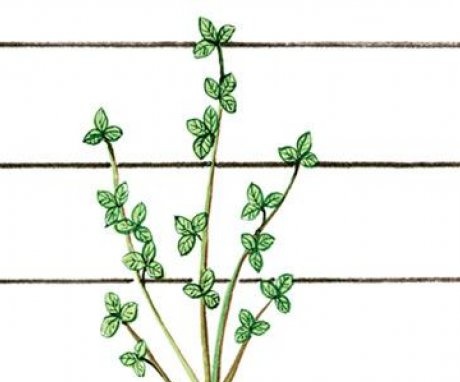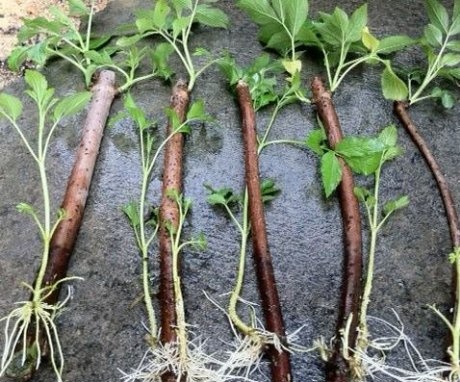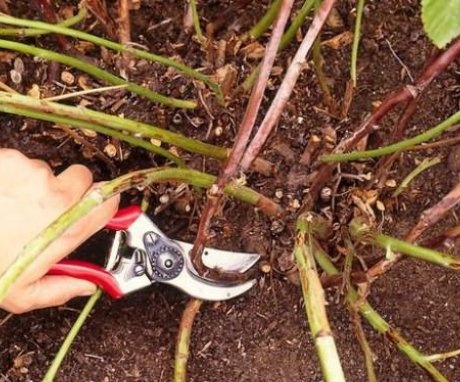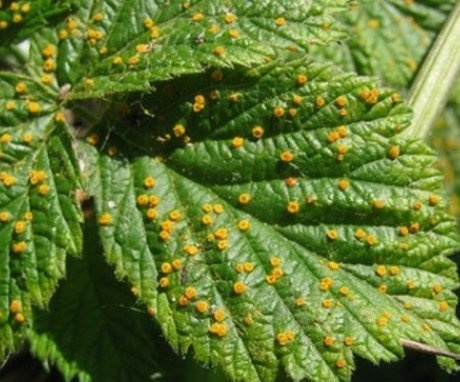Blackberry Prime Arc Freedom: the secrets of growing varieties
Thornless blackberry is rapidly gaining popularity among gardeners. These are high-yielding and unpretentious crops that can be grown in almost any climatic zone. It is suitable for cultivation in the open field and in greenhouses.
Repaired blackberries are not afraid of spring frosts and calmly winters in the ground while providing proper shelter. Such blackberries can be grown in a one-year cycle, which eliminates the need for chemical treatments and allows you to get an environmentally friendly product.
Prime Arc Freedom was introduced to the global market by Dr. Clark of the University of Arkansas in 2014. This is the first representative of the remontant blackberry, the bushes of which do not have thorns. She can give two harvests of large berries per season and belongs to the high-yielding varieties.
Content:
- What is interesting about the Blackberry variety Prime Arc Freedom
- How to plant a variety correctly?
- Reproduction methods
- Care Tips
- Protection against diseases and pests
What is interesting about the Blackberry variety Prime Arc Freedom
Blackberry Prime Arc Freedom was patented in 2013 as an early large-fruited variety. Berries are formed on last year's and young shoots, reaching a weight of 17 grams. The first berries are formed on the bushes in the year of planting, but rather late and in the northern regions the fruits do not have time to ripen.
If you provide the blackberry shoots with a reliable winter shelter, then the fruits will ripen on them at the beginning of summer, and the autumn harvest can be removed from young branches. If you cut out the sprouted shoots in the fall, then it is enough to mulch the roots with peat for the winter. But in this case, the crop will only give one late harvest at the end of summer.
Blackberry bushes are formed from thornless erect powerful shoots, up to two meters high.
The berries are large, weighing up to 17 grams, have an oval-elongated shape. The taste is sweet, but there is a refreshing sourness. Average juiciness. The high quality of the fruits is due to their one-dimensionality. The first fruits are the largest, the subsequent ones are slightly smaller. The variety is suitable for cultivation on a production scale and for personal consumption.
The advantages of this variety include:
- lack of thorns on shoots
- high quality fruit
- good transportability, in which the fruits do not wrinkle and do not flow
- ease of reproduction, which allows you to grow the variety as a two-year crop
- resistance to most diseases
- when grown in greenhouses - the possibility of obtaining off-season products from mid-spring to mid-autumn
Among the shortcomings, the susceptibility to anthracnose, low winter hardiness and late ripening when cutting branches for the winter are noted.
How to plant a variety correctly?
For remontant blackberries, the temperature regime is especially important. The culture needs warmth, but has a negative attitude to the influence of direct sunlight. To get a high-quality harvest, when planting, it is important to choose a slightly shaded place and follow some rules:
- The planting of bushes should be carried out at an interval of 70-80 cm, and 140-160 cm should be left between the rows so that it is possible to install trellises.To install the supports, you need to drive high stakes between the bushes and fix three rows of twine or thin wire horizontally on them.
- The distance from the ground to the first row should be about 45 cm, the second - 85 cm, and the third 125 cm. Blackberry shoots are fixed on the trellises and the bushes receive more uniform illumination, which contributes to the full ripening of the berries.
- The landing site must be protected from northerly and westerly winds. And the best time to plant bushes is the second half of spring ..
- Planting pits must be prepared in advance, at least a month before planting. Their depth and diameter should be about half a meter.
- The soil is light and not very fertile. It can be loamy or sandy loam with an optimal pH level of 6 to 6.6.
- The soil should be fertilized organic - humus or rotted compost, as well as wood ash.
Planting material should be purchased at specialized locations with a good reputation. When buying plants, you should pay attention to the fact that the roots are with an earthy clod. The most suitable for planting are annual or biennial seedlings, which are one or more twigs of half a meter in height.
The diameter of the main shoot should be at least half a centimeter. Also, the seedling should have a formed growth bud and a developed root system without signs of disease.
Blackberries are planted according to a certain pattern:
- if the roots were not covered with an earthen clod, then they must be placed in water or in a root-forming solution for a day. For disinfection, you can add a little potassium permanganate
- planting pits are abundantly moisturized
- at the bottom of the hole, a small earthen hill is formed, on which the seedling is installed, carefully straightening the roots
- gradually fill the hole with soil, periodically tamping the earth around the trunk. The soil should completely cover the root buds. At the end of the work, a deepened peri-stem circle should be formed.
- water the seedling and mulch soil with peat, freshly cut grass or humus
After planting, it is recommended to prune the bush, shortening all branches by half, but their length should be at least 30 cm.
Reproduction methods
Propagating Prime Arc Freedom is quite simple, because young plants take root well. Even if you grow a plant from seeds, you can preserve all varietal characteristics.
Blackberries are propagated in three main ways:
- Rooting method of cuttings. For its implementation, it is enough to bend the shoots to the ground and strengthen. Earthen mounds should be formed at the attachment points. Further care consists in regular watering and after a while roots form there. The procedure is carried out in the spring. Rooting is also possible before winter, but in this case, the plants need to be provided with high-quality shelter. In autumn, young specimens can be separated from the mother bush and transplanted.
- Root cuttings method. Planting material is harvested from the roots blackberry... To do this, the bushes are dug up and long healthy roots with a diameter of at least half a centimeter are selected. They are cut into pieces 11-16 cm long. Cuttings should be rooted in late summer or early autumn. Before planting, the cuttings are kept in a growth stimulant solution. Many gardeners practice shoot cuttings. The cut pieces are rooted in separate containers, creating a humid environment. The roots appear within a month, after which the plants are planted in the ground.
- Sowing seeds. Blackberry seeds have low germination rates and, to speed up germination, scratch the dense outer shell or refrigerate the seed for a week. The procedure is carried out in early spring. The seeds are sown in seedling boxes filled with moistened peat mixed with sand. Seed material should be deepened by 4-5 cm.Within two to three months, the first pair of leaves will form on the seedlings. At this time, you need to dive the plants into individual containers. And in stable warm weather, the transplant can be carried out to a permanent place. Planting seedlings from containers can be carried out in mid-June. Using this method, the first harvest can only be tasted after 3-4 years.
Care Tips
It is not difficult to take care of the Blackberry Prime Arc Freedom, the main thing is to follow some rules:
- Irrigation. The first month and a half after planting, blackberries need regular watering... When the plant takes root and actively starts to grow, irrigation measures are carried out as needed and during the ripening of the berries. In the summer heat, irrigation activities should be carried out twice a week or more often. Watering should be carried out with rain or settled cold water.
- Weeding and loosening. When growing blackberries, special attention should be paid to weeding and loosening. The plantings must not be overgrown with weeds. And loosening is necessary so that the root system receives enough oxygen. To facilitate the task, the soil can be mulched with sawdust or peat. This will prevent weeds from growing, and also maintain soil moisture for a long time.
- Fertilization. Blackberries have no special requirements for fertilizers. But for better development and fruiting, it is still worth feeding the plant. During the period of active growth, nitrogen-containing fertilizing is introduced. They help the culture to actively grow green mass. As fertilizers, urea or organic matter can be applied in the amount of 20 grams or 4 kg per square meter. Every year, the soil should be enriched with potash fertilizers at the rate of 40 grams per square meter. It is important to ensure that there is no chlorine in the top dressing. Once every three years, you need to apply phosphate fertilizers in the amount of 50 grams per square meter. But if the soil was mulched with manure, then you should refrain from introducing phosphorus.
- Pruning measures. If the shoots of blackberries have not been pruned for the winter, then in early spring, attention should be paid to the condition of the bushes. All damaged and frozen branches are removed to the first growth bud. And in early April, a bush is formed. It is recommended to leave no more than eight young shoots on one bush. And when they reach a length of 10 cm, the tips need to be shortened - pinched. Many do not attach importance to this procedure, but pinching is important and can significantly increase crop yield.
When the crop is ripe, it is recommended to shade the blackberry bushes, because the direct rays of the sun can have a negative effect on the appearance and taste of the berries.
Protection against diseases and pests
Blackberry Prime Arc Freedom is resistant to common diseases and is rarely attacked by insects. But if the plant is weakened, then in conditions of high humidity, fungal diseases can develop on it:
- Orange rust. A dangerous disease that affects the aerial parts of the bushes. The causative agent of the fungus hibernates in the roots and shoots of the plant. With the onset of heat, fungal spores spread throughout the bush. On the outer part of the leaf plate, yellowish pimples are clearly visible, and the lower part is covered with orange shiny spots from bubbles. When the first signs of the disease are detected, the affected bushes are removed from the site and destroyed. As a preventive measure, annual spraying should be carried out. bordeaux liquid before flowering and after harvest.
- Anthracnose... The leaves and stems of blackberries are covered with purple spots, which gradually turn into ulcers. As a result, the leaves fall off and the shoots crack. If symptoms are found, damaged shoots should be cut and burned along with infected fallen leaves. As a preventive measure, they also carry out double treatment of plantings with Bordeaux liquid. Planting should not be thickened.
- Septoria.Leaves and stems are covered with brown spots, which gradually turn white. The damaged areas become covered with mucus and die. And the berries and flowers are rotting. To combat the disease, the diseased parts are cut out. All plantings are treated with systemic fungicides.
More information can be found in the video:
Blackberries can also be attacked by harmful insects, including:
- blackberry mite, which spreads downwind, on the legs of flying insects, and is also brought in with planting material. To combat the pest, a solution of colloidal sulfur is used, which is sprayed with plantings in several stages.
- The goldfish is a shiny beetle that lays its eggs on the bark of the stems. And the hatched larvae gnaw through the bark and penetrate into the shoots. The damaged branches dry out and die. You can fight beetles mechanically - manually remove them from the bushes or shake them off. You can also use chemicals
If you carefully monitor the cleanliness of the personal plot and properly care for the blackberry plantings, then problems with diseases and pests may not arise. But preventive measures should still be carried out.
Blackberry variety Prime Arc Freedom appeared recently, but has already achieved recognition. It is impossible to take into account all the subtleties of plant cultivation, because there is not enough experience and observation to identify all the dangers. But if you follow the already known techniques and recommendations, then problems can be avoided and enjoy tasty, healthy berries.



